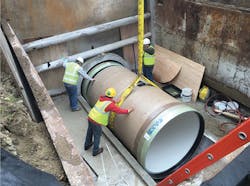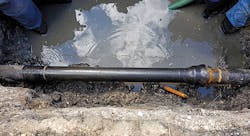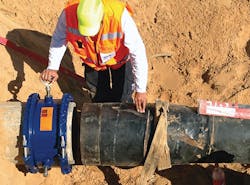More than one million miles of pipes in 51,356 community water systems deliver 42 billion gallons of water to nearly 300 million customers in America each day. Most of those pipes were installed in the first half of the 20th century. By 2020, according to The New York Times, the average age of the 1.6 million miles of water and sewer pipes in this country will be 45 years.
There are 600 utilities with iron pipes dating back more than a century, states Gregg Horn, vice president of technical services, Ductile Iron Pipe Research Association. “We’re asking our infrastructure to do things it never thought about.”
The typical lifespan of water pipes, according to the American Society of Civil Engineers, is 75 to 100 years. Despite reduced water consumption, the ASCE reports an estimated 240,000 water main breaks occur annually, wasting 2 trillion gallons of treated drinking water. That indicates a looming crisis related to the crumbling infrastructure.
According to the American Water Works Association, an investment of an estimated $1 trillion is necessary to maintain and expand service to meet demands over the next 25 years. The situation is even more complicated for smaller communities, which serve roughly 8% of the population, because they lack sufficient funding to adequately maintain, replace, or repair failing pipes.
Upfront Cost vs. Lifetime Cost
The country’s water infrastructure is “not in great shape, but too often, we use an old-school approach in an attempt to save money,” observes Firat Sever, pipeline divisions manager for QuakeWrap Inc.
The modern approach QuakeWrap uses incorporates fiber-reinforced polymer products to repair water pipes. Made of carbon, glass, or a proprietary composite featuring a thick three-dimensional core, the solution is particularly beneficial for gravity sewers, sanitary sewers, and large-diameter sewers where external loads dictate the design. The material is applied to steel and pre-stressed concrete, with the glass fiber only at the joints.
“The application determines the choice of material,” explains Sever. For each application, the pipe’s depth, diameter, condition, internal pressure, material, and traffic loads are assessed.
Advantages of this material include the fact that it’s lightweight and very strong. “Its ultimate strength is two times [that of] steel,” states Sever. That kind of strength enables it to withstand compression from external loads, making it a good choice for deep pipes. “It’s good for the most challenging projects.”
Because this type of repair doesn’t necessitate trenching or heavy equipment, it was a good solution for the Minnesota Department of Transportation when 20 feet of 12-inch diameter reinforced concrete pipe in a 100-foot-deep tunnel needed repair. Access was through the manhole. The crew had to travel half a mile horizontally in order to perform the repair. “It would have been nearly impossible with traditional methods,” believes Sever.
Although the material doesn’t require heavy-duty equipment to haul or install it, it does demand skilled technicians and the flow of water must be halted during the entire process, including curing. “It’s not flow-tolerant,” admits Sever.
The fabric is saturated with resin before being applied directly on the pipe and left to cure. Site conditions must be suitable for curing. In order to meet the required temperature, it may be necessary to apply heaters or humidifiers.
Another advantage, Sever says, is that it’s an “environmentally friendly solution.” Its carbon footprint is a fraction of that of other materials, thanks to low transport costs on top of ease of transport.
The upfront cost is higher, but lifecycle costs are competitive, he continues, because “the fabric lasts forever” and the polymer can go 50 to 100 years without maintenance. Water-activated pipe wrap is popular and is used as a permanent fix.
It's a Wrap
One of the earliest applications of polyethylene casement, according to Horn, was installed in 1958 in Lafourche Parish, LA. It was used to combat corrosion in “extremely aggressive soil,” he explains.
About every five years, the pipe is dug up for inspection. “We have dug it up seven, eight, nine times,” recalls Horn. “We uncover the pipe and remove the film to inspect for corrosion.” During inspection, they have to keep the pumps running to keep the area dry. It’s buried only 4 feet deep. “The pipe looks great because the wrap was put on the right way when it was installed.”
Tubes or sheets of polyethylene film are wrapped around the pipe in a state-of-the-art method immediately before installation in order to isolate the pipe from a corrosive environment. More recently, the bio-enhanced polyethylene film has been infused with a corrosion-inhibitor and an anti-microbial inhibitor.
The V-Bio Enhanced Polyethylene Encasement features a corrosion-inhibiting layer and an anti-microbial layer to address potential issues of anaerobic bacteria and prevent the formation of corrosion cells under the wrap. It acts as an unbonded film that prevents direct contact between the pipe and corrosive soil. Unlike bonded coatings, polyethylene encasement protects the pipe without the formation of accelerated corrosion concentration cells at coating “holidays” or gaps.
It also provides a uniform environment that eliminates corrosion cells and has a dielectric property to help control stray currents. In fact, it’s the only method of supplemental corrosion protection for ductile iron pipe that is standardized by the American Water Works Association, which has rejected a standard for the use of bonded coatings on ductile iron pipe.
Only two manufacturers are approved to make the polyethylene film because “we want tight control,” says Horn. The co-extrusion process makes the film from more than one source, infuses coloring, and produces it as one layer with a minimum thickness of 8 mil.
For years, polyethylene encasement has been one of the most popular, economic, and successful methods of corrosion control for ductile iron pipe. The American Water Works Association adopted the first national standard polyethylene encasement in 1972. An international standard was adopted in 1985. Horn firmly believes that proper design, materials, and installation contribute to effective corrosion control.
Prior to the example Horn refers to in Lafourche Parish, polyethylene encasement was used experimentally in extreme corrosive conditions in other areas, such as in Birmingham, AL, in 1951; Florida’s Everglades; and in a tidal marsh outside of Atlantic City, NJ. Successful results led to its use in in 1958 in Lafourche Parish and in Philadelphia, PA, in 1959.
V-Bio is more expensive, Horn acknowledges, but polyethylene encasement has a service life of at least 105 years, according to an AWWA report; that’s longer than any other pipe material on the market. But there are some savings; because it’s a passive system, no monitoring or maintenance is necessary.
Couples Only
Utilities are always looking for new technology that will “save time in the ditch” and save money, says Ed Nunes, product manager, Krausz USA. “Cost is always important.” That includes labor costs as well as the cost of the product itself. For example, he says, the cost of digging a ditch—especially along a busy road or in the private sector—is high. On the other hand, the cost of bad publicity for pipe bursts can be higher.
During rush hour in downtown Atlanta not long ago, there was a 36-inch main break. Crews dug up the pipe, but because other utilities and pipes were close by, they couldn’t get to the bottom of the pipe to cut out a section for replacement. Instead, they used Hymax Versa, a two-in-one wrap-around stainless steel repair clamp that acts like a coupling with a gasket for deflection. “They wrapped the pipe without cutting and were up and running in a couple of hours,” says Nunes.
Krausz, which offers products for potable water and some wastewater, Nunes says, helps crews save time with its large-diameter Hymax coupling for distribution lines and mains of 14 to 60 inches. “Other products have up to 25 to 50 bolts; ours have four bolts.” Fewer bolts and easy access speed up the repair, saving on labor costs.
Cities don’t always know the type of older pipe or its outer diameter, Nunes points out. “We can accommodate all sizes with the Hymax 2 flip gasket.” It “flips out” one or both ends for a wider angle to accommodate a large variety of pipes without changing the gasket.
Repair couplings that fit from a 6-inch to a range of sizes with six bolts to tighten have transformed to a multi-range coupling with one bolt on top on each end. They are easier to use, and go from one size pipe to a different size pipe, explains Mike Beckham, regional account manager, Core & Main, a national distribution house for water and sewer pipes. “You don’t have to worry about what’s in the ground; it will fit.” Their multi-use capability makes them cost-effective.
Utilities want resiliency, Nunes says. Krausz’s patented two-stage gaskets are designed to prevent leaks through dynamic deflection. As the ground moves, the coupling moves with it so there is no force on the pipe. Less stress on the pipe prevents new stress points. These gaskets go on the interior of a coupling and fit 1 1⁄2-inch to 60-inch pipe.
Similarly, a new item Core & Main stocks is a transition coupling with built-in restraints that grip the pipe. “They move with the ground,” states Beckham.
Clamp-Down
Due to seismic movement, utilities want infrastructure capable of moving with the ground, so several manufacturers are working on new products. This coincides with a trend in restraint by “biting” into the pipe. “A lot of utilities want restraint,” observes Nunes, explaining that other products use an external collar with tie rods or cement to prevent movement.
Another thing utilities want is a product that eliminates another product. A transition coupling is a common way to attach pipes and valves from a mechanical joint to a plain end pipe. Combined with the new Hymax Grid Cut-in Sleeves, “It’s a simple way to cut into an existing line,” allowing crews to attach and install hydrants and valves very quickly, says Nunes. It also provides full restraint.
Repair clamps from Krausz now have outlets for secondary service, Nunes says. “If there’s a crack on a pipe, you can wrap it with the clamp. Then you tap on top for water to come out for secondary service—if you need to add for a new house, for example.” The product is multi-use, allowing bypass capability for testing required by some water meters.
Last year Krausz introduced grip swivel joints that fit 4- to 12-inch pipes. Standard angles of joints previously available were 11, 22, 45, and 90 degrees, Nunes explains. If none of those was the angle needed, a combination of joints would have to be used. This adjusts from 0 to 90 degrees and locks in. It is also fully restrained on both ends. In Santa Clara, CA, there was a pipe coming out of the ground at a bad angle, Nunes recounts. “A standard joint couldn’t fit, so they used one of ours instead of multiple joints.”
But not everything has changed. Beckham reports that there’s “not much evolution” in repair clamps, except for the fact that they were originally a temporary fix, but have become a permanent fix. “Full circle repair clamps were meant as a temporary fix, but now are used as permanent,” he says, adding that “one company is trying to do a multi-use, but it’s three times the price.”
Pushing Pipe
A new product introduced by HOBAS Pipe USA to repair non-circular structural pipe is a glass-fiber-reinforced, polymer mortar pipe. Often, older municipalities have non-circular shaped pipes that carry waste and storm water, or combined sewers large enough to handle storms. Their shape is often referred to as tear drops, horse collars, or ellipticals, says John Mele, national business development manager. HOBAS has designed a repair for that non-circular shape that can be installed without bypass pumping—and with no coatings or linings needed. Focusing primarily on transmission lines (78 inches and now 112 inches), these pipes are placed inside another to replace structure that’s failing.
Couplers are commonly used around the world, but the US typically prefers to cut out bad sections of pipe to feel safer about repairs. Slip lining is a popular repair method that replaces old pipe with new poly pipe. “The toughest part of rehab is in urban areas,” recognizes DIPRA’s Horn. That’s where trenchless technology can be very efficient in allowing contractors to take advantage of existing pipe to make a repair.
“Other methods are good,” says Mele, “but there are different ways to repair, depending on the problem. If you have 12-miles of transmission line, you can’t replace that much pipe without excavating.”
Or can you? Pilot studies have been done to prove that this new pipe can be installed without excavating. Large-diameter (15 to 20 feet) transmission lines from the reservoirs in upstate New York that form an interconnected aqueduct supplying water to New York City are made of pre-stressed concrete cylinder pipe. Monitoring technology indicates the pipe is failing, so it is being replaced one section at a time.
The process involves shutting down the system because water pipes are pressurized. Then, the pipes are dropped into an access point and connected—no need to excavate. “You just push to connect them,” explains Mele. “You can install in both directions. We have pushed [as far as] 5,000 feet in sanitary [pipe] and 1,000 feet in water [pipe]. You can dig a 30-foot trench to put in 800 feet of pipe.” He says the pipes can be put virtually anywhere and pushed into place. Once in place, they are grouted.
Compared with other options, Mele believes HOBAS pipe is economical. “One thousand feet [of HOBAS pipe] is cheaper than three 20-foot lengths [of other pipe].” Not having to coat steel pipe to avert corrosion saves money. However, the depth of pipe changes the cost.
It’s a good solution for spot repairs on pipes 48 inches and bigger in diameter, Mele believes, or for lining critical sections today and connecting to other sections later. But, he admits, it’s cost-prohibitive for long-term solutions or long expanses. “We did 1600 feet of fiberglass for less, but carbon fiber material is expensive because it’s designed for pressure.”
Moving Forward, Looking Back
“It’s not brain surgery,” muses Beckham. “If it’s a pinhole leak, patch it; if it’s a coupling failure, install a new one.” The problem as he sees it is that water bills are so cheap that there are no funds to reinvest in the crumbling infrastructure. “You know that 50-year-old AC is going to have to be replaced at some point or you’re just kicking the can down the street; that’s too many band-aids. You have to make a judgment.”
What would help in making those decisions is what’s underground? “Utilities need to be prepared so they have the right product on hand to repair a failure,” continues Beckham. They need to know the type of pipe, its depth, location, and diameter, as well as the location of isolation valves (for fire hydrants). He recommends mapping and documenting this information because “the people who know it are retiring. Know what you have underground.”
Gas mains don’t break like water pipes do, Beckham observes. However, as he points out, water is becoming more valuable. As it does, things in the water industry will change.


